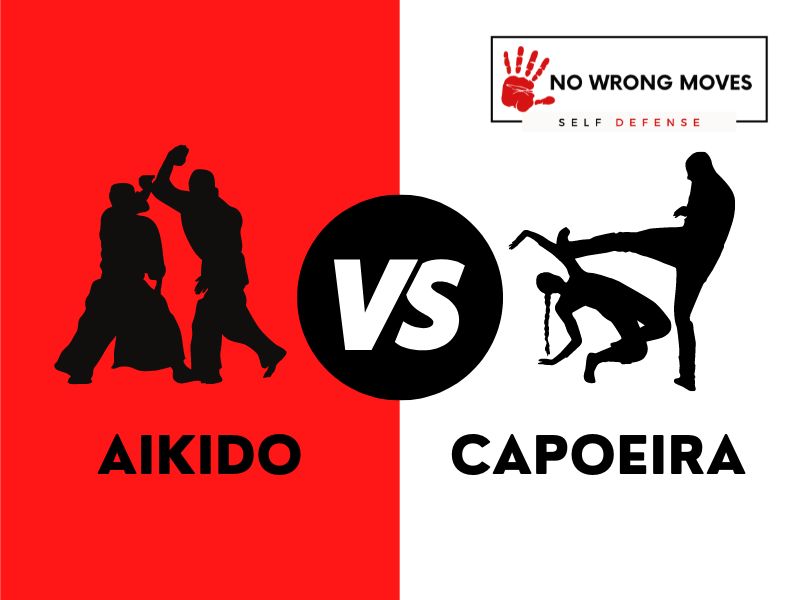
- What We Know About Aikido
- What We Know About Capoeira
- Key Elements Of Aikido
- Key Elements Of Capoeira
- Aikido Rankings & Levels
- Capoeira Rankings & Levels
- Aikido Vs. Capoeira Attire
- What A Typical Aikido Training Session Looks Like
- What A Typical Capoeira Training Session Looks Like
- Movies With Aikido And Capoeira
- Conclusion: Aikido Vs. Capoeira
Many people in the martial arts community debate whether Aikido or Capoeira is the better practice. While both offer unique benefits and principles, there are some key differences that set them apart.
The main difference between Aikido and Capoeira is the intention behind the movements. Aikido uses non-aggressive techniques to disarm and neutralize an attacker.
Capoeira, meanwhile, is a Brazilian martial art that includes elements of acrobatics and dance, with a focus on self-defense as well as attacking.
Another key difference is that Aikido focuses on using an attacker's momentum against them, while Capoeira utilizes swift movements to evade and counterattack.
In addition, Aikido is a more traditional martial art with set forms and techniques, while Capoeira has a more improvisational approach.
Ultimately, both Aikido and Capoeira can be excellent forms of self-defense, and the best choice ultimately comes down to individual preferences and goals.
But it's well worth it to note that Aikido has a stronger emphasis on discipline and control, whereas Capoeira is more acrobatic and aggressive in nature.
What We Know About Aikido
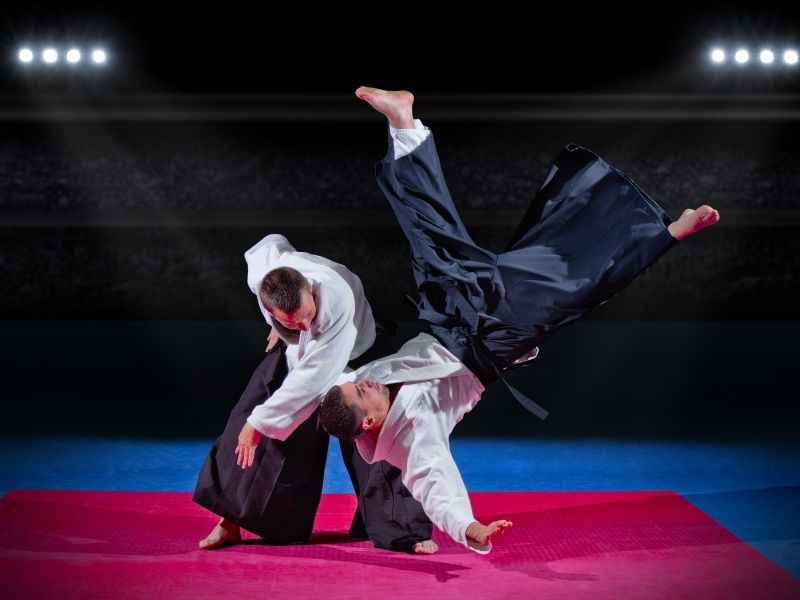
Aikido, the art of peace. Founded over fifty years ago by Master Munehide Uyeshiba who still practiced the discipline beyond the age of due to his love for this style.
It's a style that has been passed down through generations, teaching its practitioners to defend themselves while causing the least harm possible to their attacker.
The main elements of Aikido involve redirecting the energy and force of an attacker, using their own momentum against them while simultaneously controlling and neutralizing the situation. This is achieved through various throws, joint locks, and pins.
Mastering Aikido requires discipline, focus, and a strong connection to the principles of peace and harmony. It is not just an effective form of self defense, but also a way to cultivate inner peace and balance.
As Master Uyeshiba's philosophy states, the essence of Aikido is to harmonize with nature's laws, to seek unity with the universe, and to cultivate a spirit of love.
Practicing Aikido allows us not only to protect ourselves physically, but also mentally and spiritually. It is a path towards self-improvement and enlightenment. That is the true power of Aikido.
What We Know About Capoeira
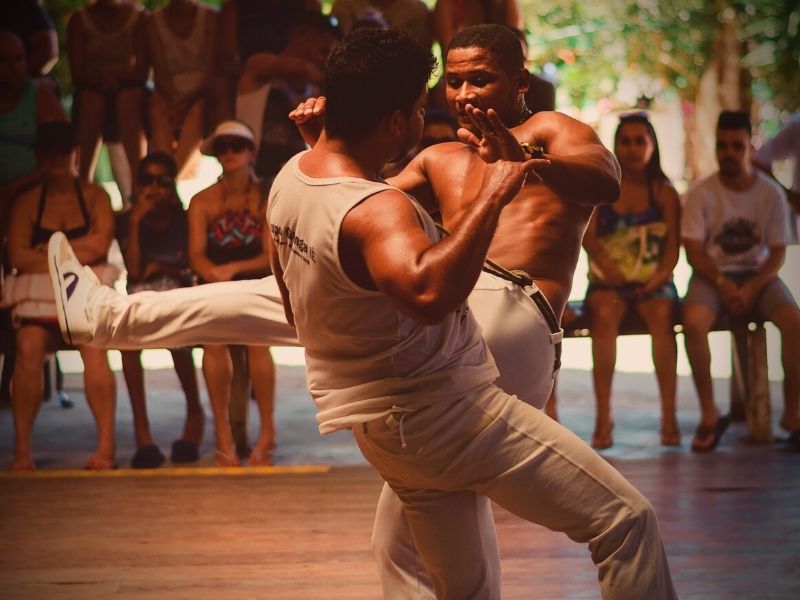
Capoeira is a Brazilian martial art that combines elements of dance, acrobatics, and music. It was developed in the 16th century by African slaves who were brought to Brazil.
The slaves used Capoeira as a way to defend themselves against their masters and to rebel against the oppressive system they were living in.
Today, Capoeira is practiced all over the world and has even gained recognition as a sport. It promotes physical fitness, self-defense skills, and cultural awareness.
Many practitioners also see it as a form of artistic expression and a way to appreciate African culture or connect with their African heritage.
While some may view Capoeira as solely a form of entertainment, it should not be underestimated. Its fluid movements and quick reflexes make it a formidable martial art in combat situations.
Regardless of its origins, Capoeira continues to evolve as a multifaceted practice that can benefit anyone who chooses to learn it.
Of course, this is only a brief history and understanding of Aikido and Capoeira, but if you want to go deeper into either art, be sure to check out the following posts:
Now, back to the comparison...
Let's look at the origins of the respective disciplines and then compare the key elements of their practices. You will be able to understand some of their similarities and differences a bit better afterward.
| Aikido | Capoeira | |
| Origins | Japanese | Brazilian |
Key Elements Of Aikido
Aikido is a Japanese martial art that focuses on the proper stance and balance of the practitioner. Proper stance and balance are critical components of Aikido, as they provide the foundation for all other techniques.
A stable and balanced stance allows the practitioner to move fluidly and with control, making it easier to perform techniques effectively.
In Aikido, practitioners learn to redirect their opponent's energy rather than using force against them. Redirecting energy is one of the fundamental aspects of Aikido, and it's difficult to separate this idea from the sport itself.
Through properly redirecting an opponent's energy, Aikido practitioners can use their opponent's momentum against them, rather than relying on their own strength.
Apart from physical techniques, Aikido also emphasizes controlling one's emotions. Practitioners learn to remain calm and focused, even in stressful situations.
Aikido also places a strong emphasis on non-violent conflict resolution. The first option in any situation is to find a peaceful resolution, rather than resorting to violence.
Remember that in Aikido, the first option is not violence, and it reflects the overall philosophy of Aikido as a martial art focused on peace and harmony.
Key Elements Of Capoeira
History
Like I mentioned, the history of Capoeira is a long and complicated one, with roots in Africa, Brazil, and Europe. A big part of what makes Capoeira... well, Capoeira, is in no small part due its history, so it's well worth it to familiarize yourself with this.
Capoeira was born out of the struggle of African held in captivity in Brazil. It was originally used as a form of self-defense and rebellion against their oppressors. Over time, it evolved into a complex martial art that combines dance, music, and acrobatics.
Music
Music is an integral part of Capoeira. It sets the pace and tempo for the game, and provides a backdrop for the movements.
The music of Capoeira is upbeat and lively, with a strong rhythm that drives the action. The instruments used include drums, guitars, and tambourines.
Movement
Movement is the heart of Capoeira. Its fluid, acrobatic maneuvers are easily what sets it apart from other martial arts.
Capoeira is all about movement and counter-movement. It is a game of evasion and attack, with both partners moving around each other in a dance-like fashion.
Another thing I think is important to look at is the different rankings and levels in each art. if you are looking to take up either Aikido or Capoeira, whether as a hobbyist or to compete, you need to understand the different levels of proficiency and what is required for testing and ranking.
Aikido Rankings & Levels

Aikido is a discipline that has many different levels, each represented by a different colored belt. The first level is white belt, which is for beginner students. Once you have mastered the basics of Aikido, you can move on to the blue belt, which is for intermediate students.
And finally, once you have mastered the art of Aikido, you can become a black belt, which is the highest level.
There are three degrees as a black belt holder: 1st dan, 2nd dan, and 3rd dan black belt. In order to achieve each of these degrees, you must pass a test that proves your mastery of Aikido.
There are also other ranks and colors that exist outside of the traditional ranking system. In some Western Aikido schools, there are more ranks added in between 1st dan and 2nd dan.
These ranks can be any combination of colors, and it allows for students to be promoted at a more gradual pace and helps to distinguish between students of different ranks.
Capoeira Rankings & Levels

Capoeira is a Brazilian martial art that has many different levels and ranks. The highest rank in Capoeira is the Mestre, which is a Portuguese word that means "master." There are only a few people in the world who have achieved the rank of Mestre in Capoeira.
Below the rank of Mestre, there are a variety of different levels and ranks in Capoeira. These ranks include Professor, Contra-Mestre, and Capoeriaista. Each rank has its own set of responsibilities and duties within the Capoeira community.
The level of a Capoeirista is determined by how well they know the art form, as well as their ability to teach and lead others. Those who are dedicated to learning and teaching Capoeira are typically promoted to a higher rank over time.
Aikido Vs. Capoeira Attire
This section simply compares the clothing and uniforms that practitioners wear in combat.
Aikido Attire:
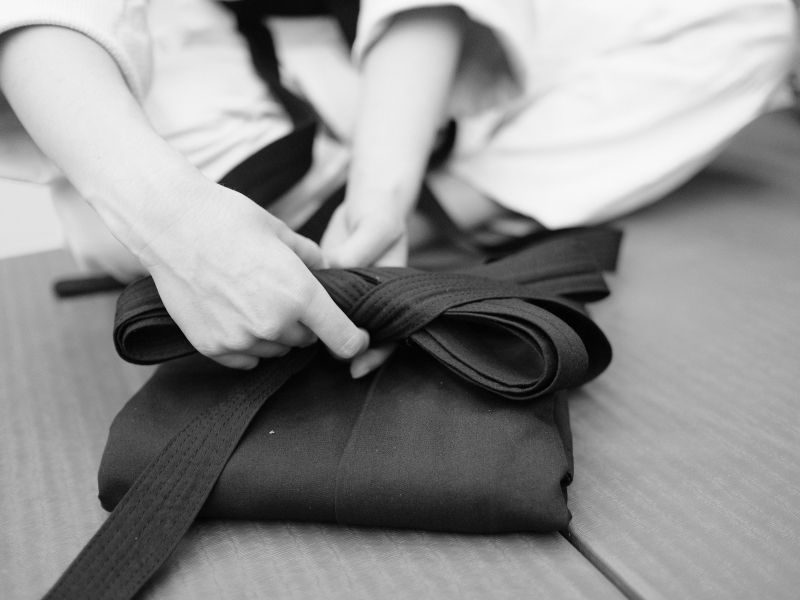
Most aikido practitioners wear a white dogi, or “uniform.” The dogi is a loose-fitting cotton kimono with a belt. In some schools, aikido students also wear hakama, which are pleated trousers that are tied at the waist and fall below the knee.
Male practitioners often don white tabi (socks), while female practitioners often wear white zori (wooden sandals). Some people also choose to practice without any clothes on in order to better feel their body and movements, but this isn't all too common.
Capoeira Attire:
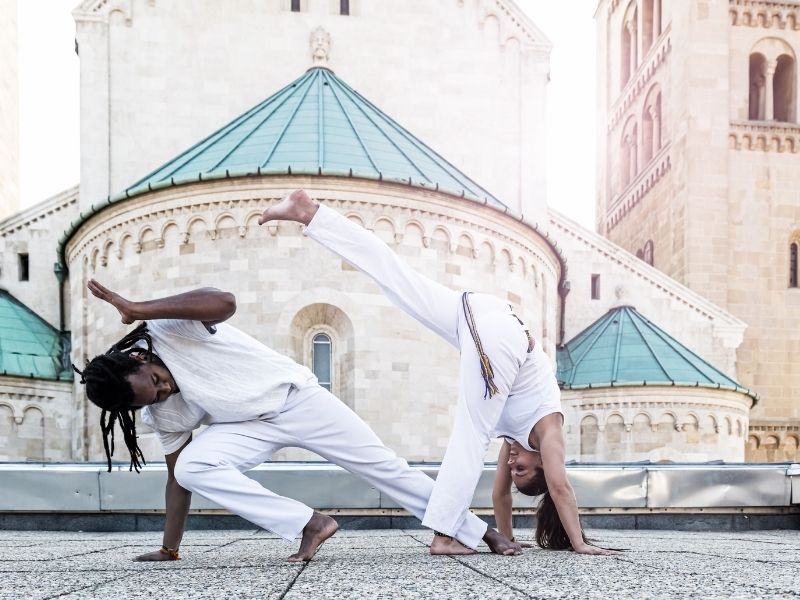
Capoeira practitioners isn't strict with its attire, and capoeiristas wear clothes that allow them to move freely and remain comfortable while practicing.
Common clothing items worn by practitioners of capoeira include T-shirts, shorts, and sandals. Some people may also choose to wear a headband to keep their hair out of their face.
What A Typical Aikido Training Session Looks Like

A typical Aikido practice session usually starts with a bow. This is a sign of respect for the dojo, the other students, and the instructor. The etiquette of aikido extends beyond just the bow, though. One must always be respectful, appreciative, and protective of all beings.
This attitude must be carried throughout the entire practice session.
Physical strain, whether during conditioning or in sparring against others, is part and parcel of Aikido. As such, practitioners need to maintain good manners and a positive attitude whenever they're in aikido class.
Aikido teaches you how to handle violence, but it still ultimately strives for peace, so never let your ego get in the way during your training.
Also remember that non-resistance is an essential element of proper aikido technique execution. Intercepting, deflecting, and redirecting an attack utilize the momentum and inertia of the attack.
Note that non-resistance does not mean being passively overpowered by the attack. But if you can avoid physical conflict, then you absolutely should.
It is also always important to maintain good posture and a relaxed body. Good posture includes maintaining your balance and keeping your center of gravity low. This helps you to be more aware of your surroundings and to respond more effectively to any situation.
Maintaining a relaxed body allows you to move more freely and makes it less likely that you will be thrown off balance by an attacker.
Similarly, be sure to focus on your breathing during aikido practice. This helps to calm and focus the mind, allowing for better decision making and execution of techniques.
Next, warm-up exercises are often done, including stretches and rolling or breakfalls (ukemi). These help to prepare the body for physical activity and prevent injury.
Following warm-ups, the instructor will lead the class through various aikido techniques and movements. These often involve practicing with a partner, called uke-nage (uke being the attacker, nage being the defender).
Practice with a spirit of cooperation, not necessarily competition. The goal is to mutually improve each other's technique and understanding of aikido principles, not to overpower or dominate the other person.
The practice session may also include weapons training, using a wooden sword (bokken) and wooden staff (jo). Weapons techniques often involve similar principles to those practiced with empty-handed techniques, but provide another layer of complexity and challenge.
What A Typical Capoeira Training Session Looks Like
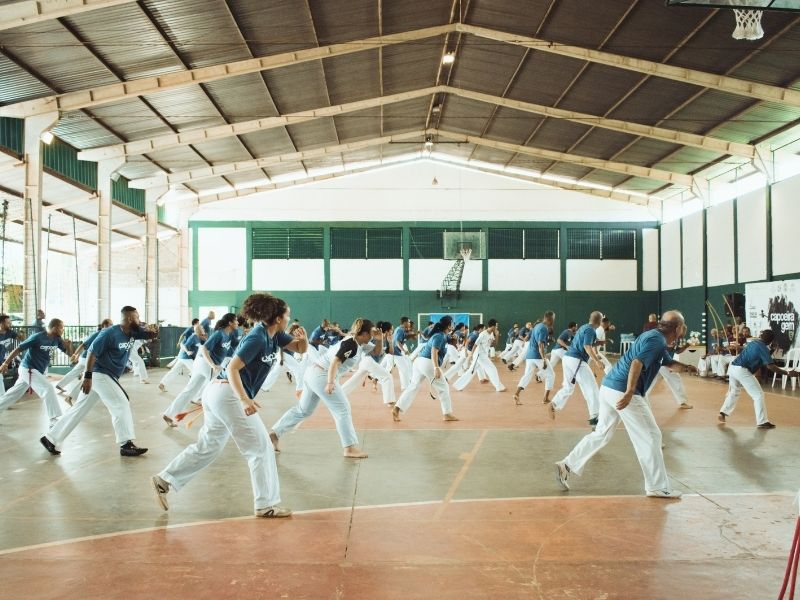
The first thing you can expect at a typical capoeira practice class is a series of warm-up exercises.
These exercises are designed to help you loosen up your muscles and prepare your body for the physical activity to come. The warm-up may include some light stretching, jogging in place, or jumping jacks.
Once you’ve warmed up, the next thing you can expect is to learn some basic capoeira movements. These movements include kicks, punches, and sweeps.
You'll likely start with simple movements and then progress to more complex ones, at least as you become more comfortable with things.
Another thing you can expect at a capoeira practice class is to learn some traditional capoeira songs. These songs are typically sung in Portuguese and are used to keep rhythm during the game of capoeira.
The lyrics of the songs often tell stories of famous capoeiristas or describe the history of capoeira itself.
Once you’ve learned some basic movements and songs, you can expect to participate in some traditional capoeira games.
These games are played between two people and usually involve one person trying to kick or punch the other person while they dodge or block the attacks. The games are usually played for points and can be quite competitive.
And finally, at the end of the class, be ready to do some closing exercises. These exercises are designed to help your body cool down after the physical activity of the class. The closing exercises may include some light stretching, jogging in place, or jumping jacks.
If the last few sections have been a bit full-on or a bit too technical, you will like this next section! Why? Because who doesn't love a good martial arts flick?
Both Aikido and Capoeira have been featured in a number of films and TV shows, so if you want to learn more about them, then entertain yourself with the following 👊
Movies With Aikido And Capoeira

These are some of the top movies and shows with Aikido in them:
- The Blind Swordsman: Zatoichi (2003)
- The Last Samurai (2003)
- Kill Bill: Vol. 1 (2003) and Kill Bill: Vol. 2 (2004)
- Street Fighter (1994)
- Ong-Bak: The Thai Warrior (2003)
- The Challenge (1982) TV series
Aikido can also be seen in popular shows such as:
- Daredevil (2015) TV series
- Arrow (2012) TV series
- Alias (2001-2006) TV series
- Chuck (2007-2012) TV series
- Xena: Warrior Princess (1995-2001) TV series
Movies you can check out with Capoeira in them:
- The Martial Arts Kid (2015)
- Only the Strong (1993)
- City of God (2002)
- The Princess and the Warrior (2000)
- Blindness (2008)
Don't forget to also check out documentaries about Capoeira, such as
- Songs from the Heart: A Journey into Capoeira (2012)
- We Love Capoeira (2013)
Conclusion: Aikido Vs. Capoeira
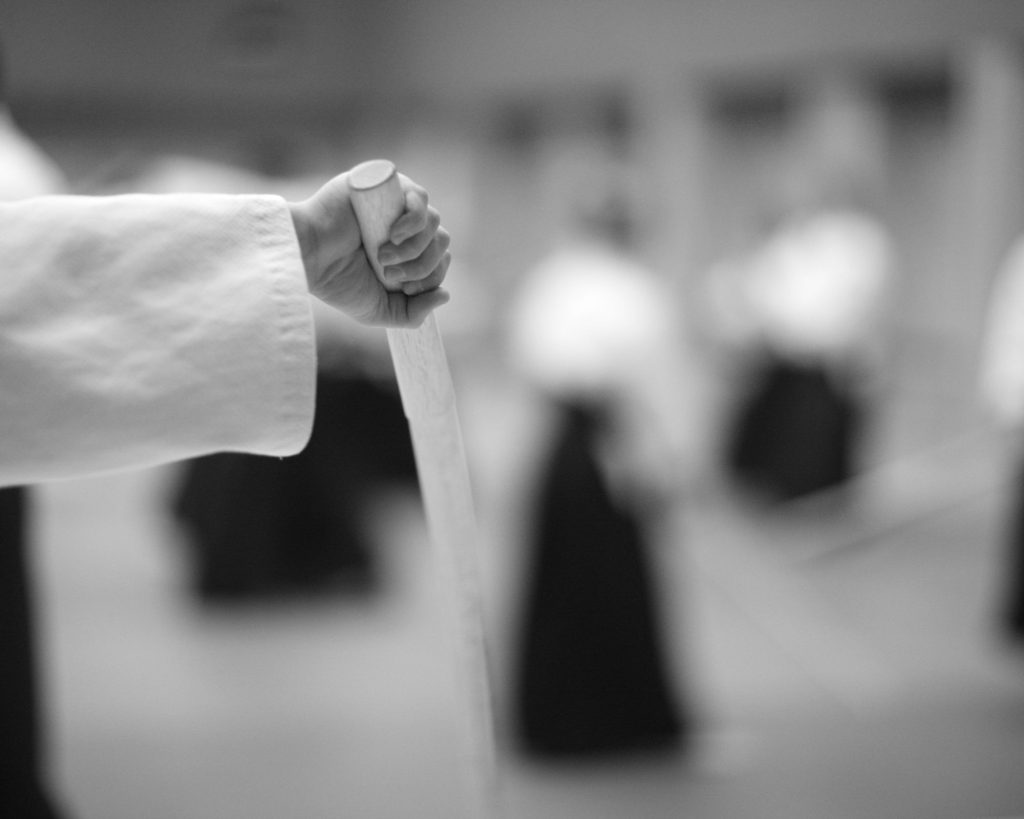
I hope you now have a deeper understanding of Aikido and Capoeira. In all truth, it is not about which discipline is "better" as they each have their pros and cons.
If you do plan on starting classes for either, please check out my other related posts, as I have tried my best to answer all the FAQs related to the art.
Feel free to share this post and any graphics you like, and of course, if you have any questions or thoughts, drop them below or shoot me an email, and I will be happy to assist 🙂
Curious to learn more about Capoeira? We've got you, just click here!
[author-box-jpx-fitness]
